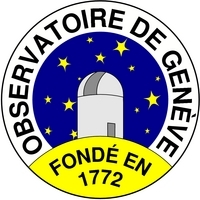
| INTEGRALPlanckGaiaPOLARCHEOPSEuclidATHENA |
| HEAVENSFACTCTALOFTSPICAJEM-EUSOXIPEeXTPTheseus |
| XRISMMAGBOUNDSMARTNet |
| ISDCCDCI |
| Data Centre for Astrophysics Astronomy Department of the University of Geneva |
INTEGRAL spectra of the cosmic X-ray background and Galactic ridge emission
| We reanalyzed the INTEGRAL Earth occultation observations of early 2006 to derive IBIS spectra of the cosmic X-ray background (CXB) and of the Galactic ridge X-ray emission (GRXE) in the ~20-200 keV range. The potential of such observations is demonstrated by the state-of-the-art hard X-ray spectra we derived for three fundamental components: the CXB, the GRXE and the Earth emission. |
|---|
ABSTRACT
Methods. We analyse the modulation of the IBIS/ISGRI detector counts induced by the passage of the Earth through the field of view of the instrument. Unlike previous studies, we do not fix the spectral shape of the various contributions, but model instead their spatial distribution and derive for each of them the expected modulation of the detector counts. The spectra of each component is obtained by fitting the normalization of the model lightcurves to the observed modulation in different energy bins. Because of degeneracy among some components, a realistic choice of the input parameters with an additional constraint for spectral smoothness is used to guide the fits.
Results. The obtained CXB spectrum is consistent with the historic HEAO-1 results and falls slightly below the spectrum derived with Swift/BAT. A 10% higher normalization of the CXB cannot be completely excluded, but it would imply an unrealistically high albedo of the Earth. The derived spectrum of the GRXE confirms the presence of a minimum around 80 keV with improved statistics and yields an estimate of ~0.6 M⊙ for the average mass of white dwarfs in the Galaxy. The analysis also provides updated normalizations for the spectra of the Earth's albedo and the cosmic-ray induced atmospheric emission.
Conclusions. This study demonstrates the potential of INTEGRAL Earth-occultation observations to derive the hard X-ray spectrum of three fundamental components: the CXB, the GRXE and the Earth emission. Further observations would be extremely valuable to confirm our results with improved statistics.
INTEGRAL observed the Earth in the night of 24-25 Jan 2006 (rev. 401), 2-3 Feb 2006 (rev. 404), 5-6 Feb 2006 (rev. 405) and 8-9 Feb 2006 (rev. 406). These data were immediately public and can be retrieved using the W3 Browse facility by following the steps below:
- Push "More options"
- In the table of catalogues, select only the "SCW - Science Window Data" and push "Specify Additional Parameters"
- In the form, enter in the "obs_id" field the values e.g.: 8860092..8860096 (for all Earth observations listed below) 8860093* (for the SCWs from revolution 404 only)
- Select SCWs you want to obtain and push "Request"
- Enter your e-mail address and push "Submit request" and follow the instructions.
| Revolutions | Observation pattern |
Observation ID |
|---|---|---|
| 401 | Staring |
88600920001 (pre-Earth obs.)1 88600920002 (Earth obs.) 88600920003 (post-Earth obs.) |
| 404 | Staring |
88600930001 (pre-Earth obs.)1 88600930002 (Earth obs.) 88600930003 (post-Earth obs.) |
| 405 | Staring |
88600940001 (pre-Earth obs.)1 88600940002 (Earth obs.) 88600940003 (post-Earth obs.) |
| 406 | Staring |
88600950001 (pre-Earth obs.)1 88600950002 (Earth obs.) 88600950003 (post-Earth obs.) |
Caution for data analysis:
Note that the observations are cut into Science Windows of ~20 minutes and are marked as Slews rather than Pointings. If you want to do an image analysis with OSA software (e.g. to identify point sources in the background field of view), make sure to change first the OBS1_ScwType parameter to 'ANY' (or 'SLEW') instead of 'POINTING'. For JEM-X analysis one has to change the value of the SW_TYPE keyword from 'SLEW' to 'POINTING' in the Science Window group. To avoid doing it by hand for each Science Window use the FTool fkeypar in a loop.
| by Marc Türler on 2010-01-14 | >> INTEGRAL science results | >> All science results |







